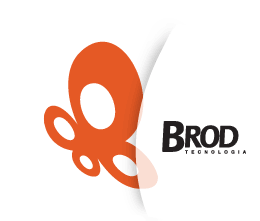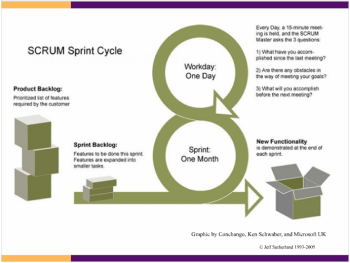|
|
Slide 24 - O ciclo do Sprint
Aqui está o slide que realmente mostra o quadro completo sobre Scrum. A Mary já apresentou uma variação dele nesta manhã. Você começa com o product backlog, criado pelo que chamamos de product owner, a pessoa que é dona do ROI (Return of Investment – Retorno do Investimento) para o produto – e trabalha com os clientes para que as especificações sejam claras o suficiente, assim o desenvolvimento pode começar. Há uma reunião no começo de cada iteração, onde o product backlog é priorizado e é deixado claro que a equipe seleciona, a partir do product backlog, o que eles pensam que pode ser feito durante esta iteração. Então eles começam a dividir as tarefas, de maneira específica para o desenvolvimento, nas quais eles irão trabalhar durante estas iterações mensais. E todos os dias eles se encontram e respondem a três questões. Todos os membros da equipe as respondem: - O que eu fiz ontem? Estes impedimentos são levantados, priorizados e tratados pelo ScrumMaster. Isto gera, caso funcione bem, um mecanismo que se auto-aprimora e que começa a transformar não só a equipe, mas também a empresa. De fato, se não transformar, irá causar inicialmente uma série de problemas dentro da empresa. E algumas vezes a equipe Scrum é simplesmente esmagada. Em outras vezes, se ela tiver sucesso, poderá ser replicada. Ela se torna um vírus que toma toda a empresa. Ao final de cada mês a nova funcionalidade é entregue, a peça funciona, volta-se ao princípio e começa-se tudo novamente. O processo é muito simples.
- What did I do yesterday? Those impediments are tracked, prioritized and dealt with by the ScrumMaster. This generates, if it works properly, a self-improvement mechanism that starts transforming not only the team but will begin to transform the company. Actually, if it it doesn't transform, initially it causes a lot of problem within the company. And sometimes the Scrum team just gets crushed. And other times, if they are successful they can actually replicate. It becomes a virus that goes throughout the company. At the end of the month new functionality is delivered, this piece is working, go back to the beginning and start all over again. So the process is very simple.
|






